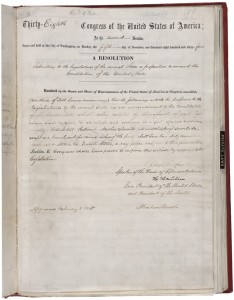Primary Sources
In your blog, describe AND LINK TO each of the primary sources you selected. What kind is each? What does each tell you about an aspect of the history of the District of Columbia. Explain how you have analyzed each of them: sourcing, contextualizing, close reading, and corroborating. Did you find one kind or primary source more difficult to work with? Why? Include an image in your blogpost. Place this post in the category Theory and Practice and be sure to add tags. (@350 words minimum).
The first primary source that I explored was a digital copy of the Joint Resolution Proposing the Thirteenth Amendment to the United States Constitution.It was written by the speaker of the House of Representatives, Schuyler Colfax, on December 5th, 1864. Colfax was in a reliable position to create this document because he was very well informed, and in a position of knowledge and power. His motive was to pass the 13th Amendment, although we cannot tell wether he himself was for the passing of the amendment, because as the speaker of the house, he had to go with the majority vote regardless. The document is believable, because it is simply a photocopy of an official document. The document itself states that two-thirds of the House of Representatives concurring agreed to pass the thirteenth amendment, and add it to the US constitution. The document states that article 1 of the 13th amendment abolished slavery and involuntary servitude (except for as punishment for a crime), and that article 2 gives Congress the right to enforce article 1 as it sees fit. The overall tone of the document is very formal, and official. This is a hugely historically significant document, because when this document was written in 1864, the Senate had already passed the document. After this document was passed, the 13th amendment was ratified in 1865. At the time of this document, slavery was still be hugely debated, and Lincoln had already issued the emancipation proclamation, but this document held the power to legally free all slaves. You cannot really corroborate other texts with this document, because it is a reprint. There aren’t other versions of it. You can’t get any more official than the actual document.  This is what the document looks like.
This is what the document looks like.
The second primary resource that I explored was a photograph of the Martin Luther King memorial that was just built relatively recently. The photographer is a man named Skip Plitt, and it was taken in 2012. The photograph depicts the marble carving of Martin Luther King, which is the main point of the monument at large. Dr. King seems to stare straight down at you, and the photograph is black and white. The monument was officially dedicated on August 28th, 2011, the 48th anniversary of the March on Washington for Jobs and Freedom. This is a very compelling, and strong photograph. It really makes the viewer think about all that Dr. King did for America, and now he has an ever dedicated spot in DC in his honor. This photograph makes you wonder about how the photographer was feeling when he took the photo, or why he took it in the first place. Did he take it because it was pretty, or did he take it to make a statement? The photograph really does show you Dr. King’s everlasting influence.
Both of these sources are important to the history of DC, from both a cultural and a historical standpoint. I think the photograph was harder to work with it, because there is less physical data to evaluate. However, I think photographs are just as powerful as documents can be, sometimes even more so. They don’t say “a picture is worth a thousand words” for nothing.
Filed under Theory and Practice | Comment (0)
Speak your mind